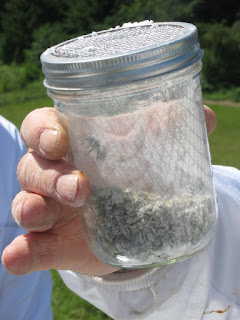 |
| 4 Varroa mites on an adult honey bee |
Do you know how many Varroa mites do you have in your colony? Are you treating, not knowing how many "ugly vampires" you have?
Varroa mites have a great impact on the health of the colony as a whole and on the honey bee itself. The mites feed on the bee's haemolymph (bee blood), as they pierce the bee's body, they transmit all kind of viral pathogens. Then the bee becomes weak, and cannot functioned properly, this affect not only the individual insect but the colony as a whole. If the Varroa mites are not under control, the hive will die within 2 years.
It is a good practice to know your mites level early in the season, so the beekeeper can make an appropriate decision based on facts. Why would you treat your colony if your mite count is low? That is plan silly, and it encourages resistance to medications. TREAT ONLY IF NEEDED!
I like to have a baseline, so I can make the right decision about my colonies. Now is the time to know your level of mite load. I use 2 simple methods: Sticky Board OR Sugar Shake. Those 2 techniques are easy on both the bees and the beekeeper!
1. Sticky Board Method:
 |
| Home made sticky board |
 |
| Sticky board after 72 hours |
I made my own sticky board, using a white poster board cut to fit the bottom of my boxes. I cover the board with petroleum jelly using a thin and small paint roller. I then cut out a screen that I attached to the board with binder clips.
I slide the unit (board and screen) through the entrance of the hive onto the bottom board.
I leave it 72 hours. Not only the mites will be on that board but a lot of debris!
I remove it, and count ONLY the mites (reddish oval things!) Because I left it 72 hours, I have to divide my mite count by 3. This result gives me the mite load in 24 hours. If you count 5-10 mites, you need to treat your colony. This is called the threshold. Many options are available to decrease the number of mites. I will write about this topic, next time.
2. Sugar Shake, or Sugar Roll
I made my own using a preserving jar, and I cut out a 1/8 screen to fit the cover. The centre ring of the preserving jar is replaced with mesh that bees cannot fall through, but varroa mites can. You will need some confectioner sugar or icing sugar. A 1/2 cup measuring cup ( ~300 bee sample) to collect bees from frames, a white container or white paper plate and a spry bottle with plain water!
The Process
- Fill the Jar with about 300 Bees. Collect bees from at least three brood frames, be sure not to collect the Queen by mistake.
- Gently roll or shake the jar so that ALL the bees are coated with the icing sugar.
- Leave the bees for one minute in a shaded location.
- Shake sugar and mites out of jar for around one minute, onto a white surface or plate.
- Spray water onto the sugar and mites in the white plate/ container. This dissolve the sugar, and it is much easier to see the mites.
- Return bees to hive. They will groom themselves and will be fine.
- If you have 3-4 mites, you will have to treat your colony.
 |
| Bees coated with sugar |
 |
| Mites onto white plate |



No comments:
Post a Comment